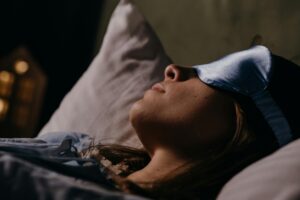Most parents of teenagers are familiar with their children’s struggles to get enough sleep. Between early school start times, homework, extracurricular activities, and the natural shift in circadian rhythms that occurs during adolescence, many teens appear perpetually exhausted. But what if your teen’s fatigue goes beyond typical teenage sleep deprivation? What if something more serious, like sleep apnea, is affecting your child?
What Is Sleep Apnea and How Common Is It in Teens?

Sleep apnea is a sleep disorder characterized by pauses in breathing during sleep. These episodes can last 10 seconds or longer and may occur repeatedly throughout the night, disrupting normal sleep patterns and reducing oxygen levels. Contrary to popular belief, sleep apnea isn’t just an adult problem. Studies suggest approximately 1-4% of children suffer from obstructive sleep apnea (OSA), with higher prevalence in certain populations such as children with obesity, Down syndrome, or craniofacial abnormalities.
The most common form in teenagers is obstructive sleep apnea (OSA), where tissues in the throat temporarily block the airway. There’s also central sleep apnea, which occurs when the brain fails to send proper signals to the muscles controlling breathing. Some teens may experience a combination of both types.
Warning Signs Your Teen Might Have Sleep Apnea
Sleep apnea is a serious sleep disorder that can affect children and teenagers alike. It is characterized by disrupted breathing patterns during sleep, resulting in frequent pauses or shallow breaths. But how can you tell if your teen is affected? Look for these warning signs:
Physical Symptoms
- Loud, persistent snoring – While not all snorers have sleep apnea, consistent loud snoring is a red flag
- Gasping, choking, or snorting during sleep
- Observed pauses in breathing during sleep
- Mouth breathing (especially during sleep)
- Morning headaches
- Dry mouth upon waking
- Night sweats
- Restless sleep
- Bedwetting that persists beyond the normal age
Behavioral and Cognitive Signs
Sleep deprivation created by sleep apnea can cause a teen to experience negative effects including mood changes such as irritability or depression, negative changes in academic performance as the exhausted teen struggles to concentrate, and weight gain due to sleep interruptions affecting hormones that control appetite.
Research from the University of Arizona found that among children who continued to suffer from OSA into their teens, there was a higher rate of problems with attention, hyperactivity, aggressiveness, difficulties controlling emotions, and managing social situations, as well as diminished capacity to care for themselves independently.
Many of these symptoms overlap with typical teenage behavior or other conditions like ADHD, making sleep apnea easily overlooked in this age group.
Why Is Sleep Apnea Treatment Important for Teens?
Effective management of sleep-disordered breathing is crucial for teens’ overall health, development, and quality of life. Without proper intervention, sleep apnea can lead to serious consequences:
The effects of obstructive sleep apnea in kids and teens include daytime sleepiness, inflammation, high blood pressure, and cardiovascular problems. A child can develop growth, cognitive, and behavioral problems as a result of poor quality sleep.
Untreated sleep apnea may affect:
- Academic performance: Chronic sleep deprivation impairs learning, memory, and concentration
- Physical development: Growth hormone is primarily released during deep sleep
- Mental health: Increased risk of depression, anxiety, and mood disorders
- Cardiovascular health: Elevated blood pressure and strain on the heart
- Metabolic function: Disrupted hormones affecting weight and glucose metabolism
The good news is that with proper intervention for sleep-disordered breathing, many of these issues can improve significantly.
Risk Factors for Teen Sleep Apnea
Understanding risk factors can help identify teens who might need evaluation:
- Obesity: Excess weight, especially around the neck, can narrow airways
- Family history: Sleep apnea often runs in families
- Anatomical features: Large tonsils or adenoids, small jaw, recessed chin
- Nasal obstruction: From allergies, deviated septum, or chronic sinusitis
- Neuromuscular disorders: Conditions affecting muscle control
- Down syndrome or other genetic conditions
- History of premature birth
- Sex: OSA is somewhat more common in males
Diagnosing Sleep Apnea in Teens
If you suspect your teen has sleep apnea, the first step is discussing your concerns with your pediatrician or family doctor. After a clinical evaluation, they may refer you to a sleep specialist.
The best way to determine whether a child or teen has sleep apnea is through an overnight sleep study (polysomnography) in a pediatric sleep lab. During this study, various parameters are monitored including breathing patterns, oxygen levels, brain activity, and heart rate while your teen sleeps.
It’s worth noting that the criteria for diagnosing sleep apnea in children and teens differs from adults. If a child has more than one interruption in their breathing each hour, that’s considered obstructive sleep apnea, while for adults, the cutoff is five pauses in breathing each hour.
Comprehensive Sleep Apnea Treatment Options for Teens
Effective sleep apnea treatment approaches depend on the underlying cause and severity of the condition. A multidisciplinary approach may include:
Surgical Interventions
Removal of enlarged tonsils and adenoids (adenotonsillectomy) is the most common surgical treatment for children with obstructive sleep apnea, with an impressive success rate of about 80%. The procedure typically lasts one hour under general anesthesia, with children usually returning to school within 1-2 weeks.
Continuous Positive Airway Pressure (CPAP) Therapy
CPAP therapy may be used in children or teenagers who have persistent sleep apnea despite other treatment efforts. This involves delivering a constant flow of air through a face mask worn over the nose or nose and mouth during sleep. However, it’s important to note that many teenagers gradually lose interest in CPAP therapy, making long-term adherence challenging.
Weight Management
For overweight or obese teens, studies have shown that reducing body fat helps reduce the severity of sleep apnea symptoms. Excess weight can put pressure on the throat and cause it to collapse during sleep. A healthy diet and regular exercise program supervised by healthcare providers can be an effective part of sleep apnea treatment.
Myofunctional Therapy
As an integrative approach, myofunctional therapy involves exercises of the tongue and lips that tone the airway and promote nasal breathing. While it must be repeated for about 45 minutes daily to reinforce the adjustments being made to the airway, it represents a safe and valuable treatment option with minimal risk of side effects.
Oral Appliances
For some teens, an oral appliance may be needed to shift the jaw and tongue forward if there is an issue with the lower jaw and tongue causing airway blockage. These devices, fitted by dental specialists, help maintain an open airway during sleep.
Positional Therapy
Positional therapy can be a helpful tool in reducing sleep apnea symptoms in children and teenagers by encouraging patients to sleep on their sides. This approach helps reduce snoring and improve breathing patterns during sleep.
Allergy Management
Children or teenagers with allergic rhinitis (hay fever) may have congestion, runny nose, watery or itchy eyes, or post-nasal drip that can contribute to sleep apnea. Treating these underlying allergies through medications or environmental controls can improve sleep-disordered breathing.
Orthodontic Interventions
In some cases, orthodontic treatments that expand the palate or address jaw positioning can help open airways and improve breathing during sleep.
Creating a Supportive Environment for Sleep Apnea Treatment
Successful sleep apnea treatment in teens often requires lifestyle modifications and family support:
- Establish consistent sleep schedules, even on weekends
- Create an optimal sleep environment that’s dark, quiet, and cool
- Limit screen time before bed (blue light can interfere with melatonin production)
- Encourage regular exercise, but not too close to bedtime
- Avoid caffeine in the afternoon and evening
- Provide emotional support throughout treatment
- Educate your teen about the importance of sleep and treatment adherence
When to Seek Help
Don’t dismiss chronic snoring or excessive daytime sleepiness as “just a phase” your teen is going through. If you’ve noticed symptoms such as snoring, hyperactivity, mouth breathing, mood changes, and daytime sleepiness, they may be suffering from sleep apnea. Obstructive sleep apnea can cause your teen to stop breathing for more than 10 seconds during sleep, triggering the brain to wake them up to breathe.
If you observe any of the warning signs mentioned earlier, consult with a healthcare provider. Early diagnosis and specialized care for sleep breathing disorders can prevent long-term health consequences and significantly improve your teen’s quality of life.
Hope for Teens with Sleep Apnea
In some cases, children outgrow sleep apnea as they develop, but others do not. Regardless, with proper diagnosis and comprehensive breathing disorder interventions, most teens can experience significant improvement in their symptoms and quality of life.
Remember that therapeutic approaches should be individualized, and what works best for one teen may not be ideal for another. Working closely with healthcare providers specializing in sleep disorders will help determine the most effective approach for your teen.
By recognizing the signs of sleep apnea and seeking appropriate treatment, you’re taking an important step toward ensuring your teenager’s health, happiness, and success both now and in the future.
Is Your Teen Struggling With Sleep? Let Zaidi Orthodontics Help
If your teen shows signs of sleep apnea, it’s important to take action early. Zaidi Orthodontics offers consultations to explore treatment options tailored to your teen’s needs.
Sleep apnea can affect health, mood, and school performance. Our experienced team will evaluate your teen’s symptoms and recommend the right path forward.
Contact us today to schedule an appointment and get the answers your family needs.

